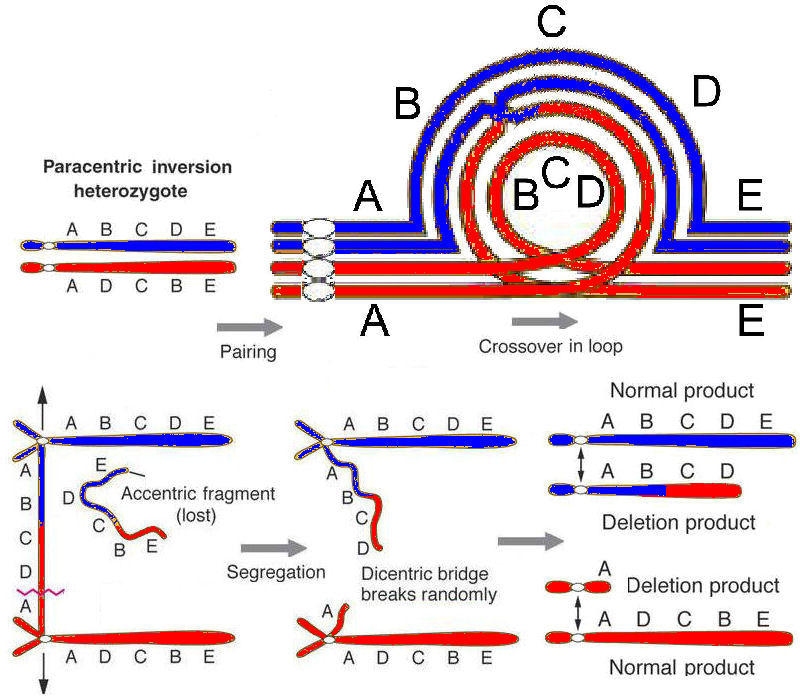
Paracentric chromosome inversion:
production of acentric fragments, dicentric bridges, & deletion products
In
the chromosome inversion,
the chromosome segment including B-C-D
is inverted in the lower as compared with the upper ABCDE chromosome. This
is called a paracentric
inversion, because the segment does not
include the
centromere. When the chromatids
double and the chromosomes pair, the inverted segment
requires the
inverted ADCBE
chromosome to form a loop in order for the gene loci to
align properly:
note that the ABCDE
chromosome
remains linear.
A crossover anywhere in the inverted region produces a dicentric bridge (with two centromeres) and an acentric fragment (with no centromere). To identify the dicentric chromosome, trace the top chromatid in the tetrad from right to left, back to its centromere: then trace the second chromatid from left to right, through the inversion region, where it crosses over to the third chromatid. Continue tracing: note that this leads back to the centromere, and finally to the fourth chromatid. Repeat this tracing, this time noting the order of loci: this should be E D C B A (o) A B C D A (o) A D C B E , as shown in the second part of the diagram. Similarly, to identify the acentric fragment, trace the bottom chromatid of the tetrad from right to left, through the inversion, and out through the right-hand end of the second chromatid. Note the absence of a centromere, and the locus order, which should be E B C D E.
During telophase of Meiosis I, the two centromeres of the dicentric segregate to either pole of the cell, and the bridge is broken randomly. The acentric fragment does not move to either pole and is typically lost. This produces two deletion products, in which one chromosome has the complete set of loci in the standard order, and the other is missing one or more loci.
A crossover anywhere in the inverted region produces a dicentric bridge (with two centromeres) and an acentric fragment (with no centromere). To identify the dicentric chromosome, trace the top chromatid in the tetrad from right to left, back to its centromere: then trace the second chromatid from left to right, through the inversion region, where it crosses over to the third chromatid. Continue tracing: note that this leads back to the centromere, and finally to the fourth chromatid. Repeat this tracing, this time noting the order of loci: this should be E D C B A (o) A B C D A (o) A D C B E , as shown in the second part of the diagram. Similarly, to identify the acentric fragment, trace the bottom chromatid of the tetrad from right to left, through the inversion, and out through the right-hand end of the second chromatid. Note the absence of a centromere, and the locus order, which should be E B C D E.
During telophase of Meiosis I, the two centromeres of the dicentric segregate to either pole of the cell, and the bridge is broken randomly. The acentric fragment does not move to either pole and is typically lost. This produces two deletion products, in which one chromosome has the complete set of loci in the standard order, and the other is missing one or more loci.